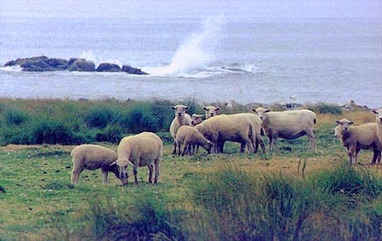Summary | Excerpt | Reading Guide | Discuss | Reviews | Beyond the Book | Read-Alikes | Genres & Themes | Author Bio

This article relates to The Guest Book
 Sarah Blake's The Guest Book is set predominantly on a private island off the coast of Maine owned by the Milton family. There are roughly 3,000 islands in Maine's territory, some that are popular vacation spots, others that are entirely uninhabited.
Sarah Blake's The Guest Book is set predominantly on a private island off the coast of Maine owned by the Milton family. There are roughly 3,000 islands in Maine's territory, some that are popular vacation spots, others that are entirely uninhabited.
Islands like Chebeague, Vinalhaven and Mount Desert are some of the most popular vacation destinations, and also have relatively sizable year-round populations. Chebeague is located just 10 miles from Portland and features beaches, scenic hikes, blueberry patches and the Chebeague Island Inn. Vinalhaven is a 2 hour ferry trip from Rockland and contains the largest year-round population of all the Maine islands. Popular tourist sites include the swimming quarries, nature preserves and the Tidewater Inn. Mount Desert is Maine's largest island, and boasts the Acadia National Park, a shopping and restaurant district called Bar Harbor and Thurston's Lobster Pound, famous for its lobster rolls. Mount Desert is one of the few islands accessible by car via Maine's Route 3. This island has a long, fascinating history, from 6,000 year old Native American encampments to its colonization by French Jesuits, and numerous territorial conflicts between the British and French in the 17th and 18th centuries.
Only 15 of Maine's islands are occupied by residents year-round, and many of these individuals enjoy the rough, homesteader lifestyle this entails. Matinicus, for example, was home to 20 people over the winter of 2018. This island is smaller than Manhattan's Central Park and contains a one-room school (with two students), a post office, a church and a library. Most of the inhabitants are lobster fishermen. The ferry to the mainland stops in Matinicus once a month, though there is an air strip bush pilots use to transport people and supplies via Cessna.
Three tiny islands off the coast of Maine, Little Nash, Big Nash and Flat Islands, are populated entirely by sheep for most months of the year. These islands are home to the flocks of Compass Rose Farm, owned by the Wakeman family. They have a home on Big Nash where they reside during the month of May when the sheep give birth (Farmer Alfie Wakeman brings rams to each of the three islands in December). Prior to the Wakemans, these sheep farms were run by Jenny Purington Cirone, who grew up on Little Nash where her father was a lighthouse operator (Maine's lighthouses could be the subject of an entire article in themselves, but the one on Nash Island was built in 1838, and Jenny's father began his watch in 1916). Jenny managed the sheep until she was in her 80s and passed away in 2004. The islands are favorable for sheep-raising due to the lack of predators and relatively low cost of land, though the population of herring gulls pick off some of the lambs.
With so many islands to choose from, there is potentially something for everyone, even if you can't afford your own private vacation destination like Sarah Blake's Milton family.
by Lisa Butts
Sheep on Nash Island, courtesy of New England Lighthouses
Filed under Places, Cultures & Identities
![]() This "beyond the book article" relates to The Guest Book. It originally ran in May 2019 and has been updated for the
May 2020 paperback edition.
Go to magazine.
This "beyond the book article" relates to The Guest Book. It originally ran in May 2019 and has been updated for the
May 2020 paperback edition.
Go to magazine.
Your guide toexceptional books
BookBrowse seeks out and recommends the best in contemporary fiction and nonfiction—books that not only engage and entertain but also deepen our understanding of ourselves and the world around us.